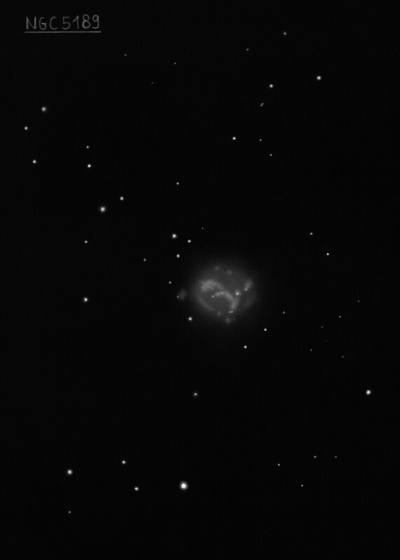
NGC 5189 (Gum 47, IC 4274, nicknamed Spiral Planetary Nebula) is a planetary nebula in the constellation Musca. It was discovered by James Dunlop on 1 July 1826, who catalogued it as Δ252. For many years, well into the 1960s, it was thought to be a bright emission nebula. It was Karl Gordon Henize in 1967 who first described NGC 5189 as quasi-planetary based on its spectral emissions. Seen through the telescope it seems to have an S shape, reminiscent of a barred spiral galaxy. The S shape, together with point-symmetric knots in the nebula, have for a long time hinted to astronomers that a binary central star is present. The Hubble Space Telescope imaging analysis showed that this S shape structure is indeed two dense low-ionization regions: one moving toward the north-east and another one moving toward the south-west of the nebula, which could be a result of a recent outburst from the central star. Observations with the Southern African Large Telescope have finally found a white dwarf companion in a 4.04 day orbit around the rare low-mass Wolf-Rayet type central star of NGC 5189. NGC 5189 is estimated to be 546 parsecs or 1,780 light years away from Earth. Other measurements have yielded results up to 900 parsecs (~3000 light-years).
300/350mm - 12" (6/29/02 - Bargo, Australia): this is a bright, strange-looking PN with a complex bar structure dubbed the "Spiral Planetary". At 140x and UHC filter, it resembles a small barred spiral galaxy with prominent bar extending SW-NE with curved tips, ~1' in length embedded within a fainter, slightly elongated halo of ~2'x1.5'. A few stars are superimposed. At 186x, the "bar" is irregular and knotty with a bright knot at one end. A mag 11 star is at the SW end with a couple of faint stars on the opposite end. The faint 14th magnitude central star is just south of the bar. Located 6' NNW of mag 7.2 SAO 252366 in a rich star field in the NE corner of Musca. NGC 5189 was a fascinating sight!
400/500mm - 18" (7/6/05 - Magellan Observatory, Australia): the "Spiral Planetary" is certainly one of the most remarkably structured planetaries and would be famous if located in the northern hemisphere. At 128x using a UHC filter, a high surface brightness "bar" at least 1' in length, elongated SW-NE forms the main body of the planetary. The bar is slightly curved and has an irregular surface brightness. On the NE end is a prominent bright knot, roughly 6" in size. Nebulosity hooks below this knot, extending below the bar. Above the southwest end of the bar is the brightest superimposed star and a hook of nebulosity sweeps up to the northwest, wrapping above this star. The entire structure is encased in a much fainter oval envelope. A total of five stars are superimposed including a very close double that is just south of the southwest end of the bar and the 14th magnitude central star situated southeast of the center of the bar.
600/800mm - 24" (4/11/08 - Magellan Observatory, Australia): NGC 5189 was the last of 78 objects that I logged on 4/11/08 and the perfect end to a great evening with the 24". At 200x using a UHC this amazing planetary displayed an extremely complex morphology. Through the center is a bright, high surface brightness "bar" elongated WSW-ENE and ~1.5'x0.4' in size. This central feature has an uneven surface brightness with a mottled texture. A mag 12 star is superimposed just north of the west-southwest end and the fainter central star is just south of the bar. A close double star (~3.5") is superimposed just south of the west-southwest end. At this end a spiral extension hooks around counterclockwise to the north and passes through a faint star and ends at a very faint small knot just north of the superimposed star. A bright 10" knot is just south of the ENE end of the central "bar". Attached to this knot is another extension that sweeps towards the southwest, ending less than 1' S of center. About 50" E of the bright knot is another 10" knot that appears detached. A mag 12 star is ~50" SW of this knot, just outside the halo of the planetary. All of the brighter features are within a much fainter oval envelope, ~2.5'x2.0'.